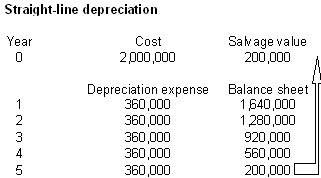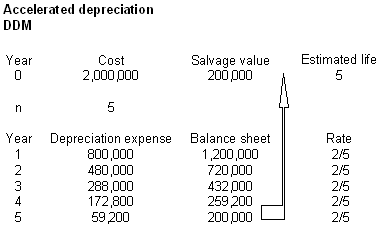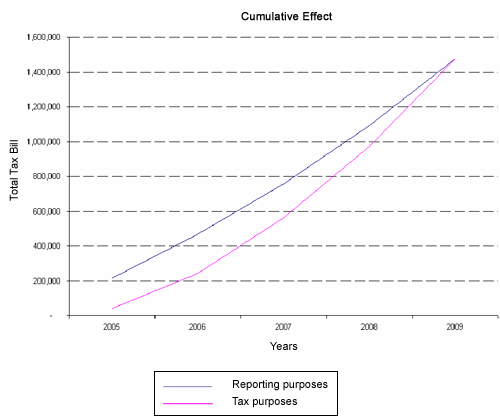CFA Level 1 - Liabilities
Temporary (or timing) differences between book income versus taxable income are due to items of revenue or expense that are recognized in one period for taxes, but in a different period for the books. Book recognition can come before or after tax recognition. These revenue and expense items cause a timing difference between the two incomes, but over the "long run", they cause no difference between the two incomes. This is why they are temporary. When the difference first arises, it is called "an originating timing difference". When it later reverses it is called "a reversing timing difference". Here are two examples of temporary differences: (1) the calculation of depreciation expense by means of the straight-line method for books and by means of an accelerated method for taxes, and (2) the calculation of bad-debts expense by means of the allowance method for books and by means of the direct write-off method for taxes
Over the life of the firm, total depreciation expense and bad debts expense are unaffected by the method. What is affected is how much expense is recognized in any given period. Temporary differences are said to "reverse" because if they cause book income to be higher (or lower) than taxable income in one period, they must cause taxable income to be higher (or lower) than book income in another period.
Permanent differences are differences that never reverse. That is, they are items of book (or tax) revenue or expense in one period, but they are never items of tax (or book) revenue or expense. They are either nontaxable revenues (book revenues that are nontaxable) or nondeductible expenses (book expenses that are nondeductible). Examples of permanent differences are (nontaxable) interest revenue on municipal bonds and (nondeductible) goodwill (GW) amortization expense under the purchase method for acquisitions. A good example of GW amortization is when one company purchases another company or any asset at a price that exceeds its recorded book value. This would be recognized partially at the time of purchase and partially over a period of time using standard amortization schedules. These are often referred to non-cash items of expenses or revenues and again are heavily scrutinized by analysts.
Calculating Income Tax Expense, Income Taxes Payable, Deferred Tax Assets, and Deferred Tax Liabilities
We'll explain this concept by example:
Company ABC purchased a machine for $2m with a salvage value of $200,000. It used the accelerated depreciation method for tax purposes and straight-line depreciation for reporting purposes. Tax rate is 40%.


Tax differential:

Make sure you know the following for your exam:
Total tax bill is the same.
Timing differences create a tax liability.
Calculation:
Income tax expense = reported income before tax * tax rate
Income tax payable = IRS reported income * tax rate
Deferred tax liability (asset) = income tax expense - income tax payable
Figure 9.1: Cumulative Effect of Total Taxes







0 comments:
Post a Comment